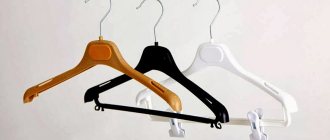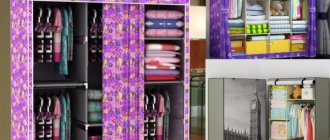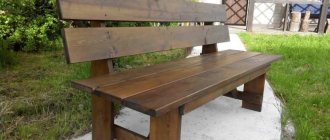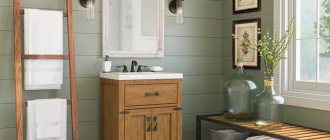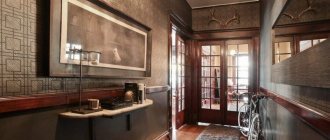Metal hangers
Strong, lightweight and durable. They are not deformed, but a lot depends on the metal from which they are made. They are usually made of steel and aluminum. You should not hang heavy jackets and coats on aluminum ones.
Advice: It’s better to get rid of cheap wire models. They do not support weight, and besides, they can get dirty, leave snags, and electrify the item.
It is more practical to buy hangers made of rubberized metal, but it can be difficult to wash (the top layer of braid becomes covered with pellets), and this is not entirely useful for clothes.
Types of floor hangers and their location
Floor hangers can be divided into several categories according to their design characteristics:
These standing hangers are most often seen near doors.
- for outerwear;
- racks for hanging hangers;
- suit, for shirts, trousers;
- hanging chairs.
Some types of floor hangers are placed in certain rooms. For example, hangers for outerwear are placed in the hallway near the door. This is convenient: you can immediately get rid of clothes. A floor hanger with hangers is more versatile. Such products can be placed in the hallway, in the dressing room, even in the nursery or bedroom. They accommodate a large amount of clothing and can replace a wardrobe.
Hanging racks are good in bedrooms and dressing rooms or in those rooms that replace them
Standing hangers for suits, shirts and trousers are most often “registered” in bedrooms or children’s rooms (if the child is a schoolchild). This is where we usually dress before leaving the house. Hanging chairs are also placed there. This is, in fact, one of the options for costume hangers. The legs and supports simply took the shape of the seat.
Wooden hangers
They are made from hardwood. The most expensive, but durable. Easily withstands outerwear. When choosing such hangers, you need to pay attention to the quality of polishing and metal of the hook-holder.
They must be smooth and varnished, otherwise it is easy to damage clothing or splinter your hand.
Classic, made of relatively thick slats, with a crossbar and a strong hook - just the thing for outerwear. Thin ones without a crossbar are suitable for second-layer clothing (if optimally smooth). An important advantage is that they remove static electricity from the fabric.
Existing types
Today, manufacturers have diversified the design and operational parameters of clothing hangers. By purpose you can distinguish hangers:
- for children - they are small in size. More often used in shops and exhibition centers than in everyday life;
- suits - indispensable for those people who prefer a business style of dress;
- for outerwear - they are highly durable to withstand the weight of a winter down jacket or coat;
- for underwear, sundresses - they have special recesses for the straps of bodices or sundresses, which allows you to securely fix the outfit. The lightest, most beautiful hangers. Basically, such products can be found in lingerie stores, trading floors, and exhibition centers;
- for trousers, blouses - they have special clips with which you can fix the trouser leg without damaging the fabric. There will be no creases or other types of defects left on the clothes, which captivates many users.
Children's
Costume
For trousers
For underwear
For outerwear
Depending on the place of use, hangers are distinguished for:
- corridors - are highly durable, as they are intended for storing outerwear;
- bathrooms - used to place towels and bathrobes;
- children's - they have a bright design and are smaller in size, as they are used for storing children's clothes.
Depending on the design features, hangers are:
- hanging separately with the ability to be removed from the rod without additional complications;
- part of a single structure without the possibility of detachment. They can often be seen in showrooms and modern interiors of entrance areas.
Additional properties
Many models have a crossbar or two clothespins along the edges. It is better to hang skirts on clothespins, and a crossbar is more suitable for trousers. The rounder and thicker it is, the better; a thin crossbar will leave a crease in the fabric.
Hangers for scarves, ties, etc. - there are others. They have a second hook, under the main holder. Or rings on the crossbar. Or they are shaped like half a chamomile. It is most convenient to hang accessories on rings and loops.
Ideal hangers for everything:
- non-slip,
- relatively wide, but not massive,
- with crossbar,
- for blouses - the same width as the back of the product, for trousers - such a width so that the product does not gather like an accordion,
- with rotating hook holder,
- with hooks at the bottom for loop holders on skirts.
What else should you keep on hangers?
Both plastic and wooden hangers have special hooks at the top for storing skirts, dresses and tank tops, as well as dresses and blouses with a wide neckline or neckline. Such products have special thin straps sewn on the inside, which cling to the hooks on the hangers. Such models of hangers can also have several crossbars (each with separate hooks); several identical items of clothing are stored on them.
ShutterStock
Leroy Merlin
- Storage systems
8 storage ideas for those who have a lot of clothes but no space
Standard sizes
| Purpose, who is suitable | Width, cm |
| Children's | 25 |
| For petite girls with sizes 38-42, or XS | 39—41 |
| Clothing size 46-50 | 41—43 (metal hangers), 45 (wooden) |
| For L sizes | 43 |
| XXL | 46 |
| Men with clothing sizes 44-46 | 43 |
| For size L (48-50) | 46 |
You can also find hangers with a width of 55 cm - you just need to look.
Clothes weight
Let's start with the fact that different items of clothing have different weights. Therefore, the first thing we need to look at is whether the corresponding hangers can withstand this load.
This is especially important for organizing wardrobes: in places where public events are held, the flow of visitors can be very impressive, which means that the equipment quickly becomes unusable. If, in addition, the hanger itself is not intended for storing, for example, fur coats or fur coats, then we can say with confidence that it will not last long.
To prevent weight from having a destructive effect on the structure, designers increase the width of the “shoulders” themselves. This allows you to distribute the load over a large area and relieve tension from the weakest point - the point where the hook connects to the shoulders.
Please note that there are also designs in which this point is missing, since the entire hanger is a single unit. Usually these are plastic models. But they have disadvantages:
- Since the hook does not rotate around its axis, it is not so convenient to hang and remove clothes from the hanger;
- Clothes are more prone to wrinkles;
- From an aesthetic point of view, solid plastic hangers are somewhat inferior to other models.
For lighter items, there are savings to be had as thinner hangers tend to cost less. For example, if you sell lightweight summer T-shirts, then you can choose lightweight plastic models.
Separately, we note the workwear. It is usually very heavy and must be stored properly. Therefore, if you need to buy hangers specifically to provide for your workers, then it is better not to skimp on quality, materials and sizes.
DIY hanger
You can make soft hangers for delicate fabrics yourself. As a basis - scraps of a plastic pipe of small diameter. You will also need:
- foam rubber or synthetic winterizer;
- double sided tape;
- fabric for covering;
- hook (buy ready-made or twist from thick wire).
How to assemble:
- A hook is embedded in the middle of the tube.
- Then the soft padding is attached using double-sided tape.
- Rectangular covers are sewn from finishing fabric along the length of the pipe (with a small margin), which are stretched on both sides and connected with a hidden seam under the hook, covering all protruding parts.
Strictly speaking, there is no perfect hanger. Each type of clothing and size has its own model. Wooden - for a fur coat, thin plastic - for clothes of the second layer, durable metal ones in silicone or rubber braiding - for clothes of the second layer and light outerwear, from windbreakers to coats.
What materials are used to make hangers?
There are several material options:
wood: birch, beech, cherry, pine, cedar and bamboo; plastic and plexiglass; metal: aluminum and stainless steel; various combinations of materials - a metal rod in silicone, which prevents clothes from slipping; satin, velvet and foam rubber, which are used for delicate fabrics.
Stylish do-it-yourself solutions
An original hanger can be made not only from expensive materials, but also from improvised means. You can use an old floor lamp, removing unnecessary elements from it in the form of a lampshade and wires, and then screwing hooks to the stand. The result is a simple and uncomplicated design.
Example of a floor hanger from a floor lamp
An interesting solution would be a designer hanger. It may differ in the number of parts and design. This design is easy to fold and transport. Regardless of the material from which the hanger is made, it will look extraordinary and stylish.
An example of an assembled designer hanger
Unneeded construction supplies can be the perfect option for a designer hanger. To do this, you can use a wooden one:
- stand;
- stairs;
- stepladder.
By using your imagination, you can turn such a seemingly useless thing into a stylish interior element that is convenient for storing clothes.
Even an old staircase that has been lying around in the garage for a long time can become part of the interior
Instruction No. 1 – do-it-yourself wooden floor hanger
To create a stylish piece of furniture and a functional hanger, you need to use old, dried wood.
Example of a finished design
Step No. 1 – preparing the material
To get a beautiful hanger you need to process the tree trunk. In order for the structure to have a presentable appearance, it is necessary:
- remove unnecessary branches and twigs;
- remove the bark;
- sand the surface of the barrel.
All parts of the hanger must be smooth. This is necessary to protect clothing and floor coverings from any damage.
Treatment of the barrel will protect clothes from damage
Step No. 2 - structural stability
Good stability can be ensured with a low center of gravity. To do this, the treated barrel must be attached to a wooden or metal circle or cross.
You can attach the support to the trunk using self-tapping screws and a screwdriver
It is important to cover the base with soft material that:
- will protect the floor covering from damage;
- will allow you to move the hanger freely around the apartment.
Step No. 3 - processing the barrel
To protect the hanger from negative external factors and give it an attractive appearance, the trunk must be treated. To do this, you need to use varnish or paint of a suitable color. This design can completely transform the interior of a room.
You need to choose only a high-quality wood treatment product; cheap options will negatively affect the condition of the structure and its service life.
Instruction No. 2 - an easy way to create a floor hanger
Anyone can make such a hanger, even without any specific knowledge. You just need to prepare the following materials.
- Four crossbars with a diameter of 2 centimeters and a length of 180 centimeters.
- Rope for tying sticks. It can be replaced with any durable decorative thread.
- Gold spray paint for painting legs.
- Four types of paint for each leg. You can choose any color.
- Masking tape.
To create an original hanger you will need a minimum set of tools
Step No. 1 - painting the legs
You need to start by painting the legs. When the paint has dried, you can continue working according to the following algorithm.
- Apply masking tape to the place where you will begin painting the golden color (approximately at a height of 30-40 centimeters).
- Carefully spray the area with spray paint.
Painting tape can be removed after the paint has dried
Step No. 2 - shaping the hanger
Once the paint on the boards has dried, you can begin assembling the structure. To do this you need:
- tie all the supports with rope
- push the posts apart, giving them the shape of a wigwam.
It is better to space the legs wider, otherwise the design will:
- inconvenient to use;
- shaky.
You need to tighten the rope tightly, otherwise the hanger will simply fall apart
This hanger is ideal for placement in the corner of the room.
Advantages and disadvantages
Before choosing a floor hanger, you need to familiarize yourself with its features. Among the shortcomings, one can highlight only questionable stability, especially in inexpensive models. However, this minus will be insignificant; you just need to think about it in advance:
- the place where it will stand;
- what things can be stored on it.
Considering these features, it will not be difficult to choose the most stable design.
Each hanger model has its own purpose
Table 1. Main advantages of wooden floor hanger
| Description | Description |
| Mobility | Such furniture is easy to move around the apartment, which is important if repairs have been made or you just need to rearrange it. |
| Does not require installation work | Installation of the floor model does not require any specific installation work. If necessary, it can be freely moved around the apartment. |
| A wide range of | This design:
|
Floor hangers vary in design
